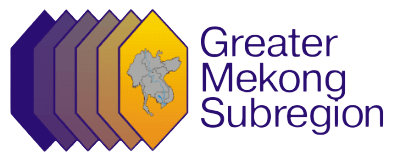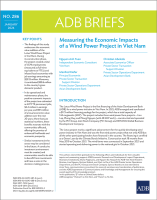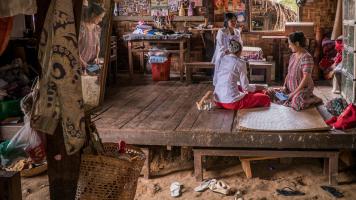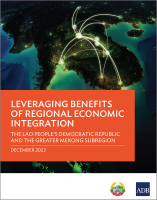Countries in the subregion should make sure recovery plans are climate-smart, pro-poor, and pro-growth.
The coronavirus disease (COVID-19) pandemic has disrupted people’s lives and well-being, led to widespread job losses, and created extraordinary uncertainty with long-lasting effects. As with climate change, the pandemic has disproportionately affected the most vulnerable people across the globe, including those in the Greater Mekong Subregion (GMS).
Different countries have mobilized stimulus packages of nearly $11 trillion to recover from the health and employment impacts of the pandemic. The Asian Development Bank (ADB) announced assistance of $20 billion to support COVID-19 recovery efforts in Asia and the Pacific.
“The recovery from COVID-19 is expected to be slow and uncertain, but it provides us a unique opportunity to make transformational changes in our society critical to fulfill the Sustainable Development Goals, the Paris Climate Agreement, and the Nationally Determined Contributions,” said Srinivasan Ancha, principal climate change specialist, Southeast Asia Department, ADB, speaking to policy makers and government officials during the GMS Working Group on Environment (WGE) dialogue held via video conferencing on 23 June.
The 2020 Global Risks Report by the World Economic Forum ranked the highest risks perceived by more than 750 global experts and decision-makers. For the first time, the top five global risks for the next decade were climate- and environment-related. Therefore, Ancha urged countries implementing or contemplating large stimulus packages for addressing the COVID-19 pandemic to assess their plans based on climate-smart, pro-poor, pro-growth criteria. He identified eight priorities to stimulate a green and resilient recovery in the GMS:
- Build holistic community resilience and promote shared prosperity. Vulnerable people are the most impacted by both COVID-19 and climate change. Policy makers must ensure that stimulus packages deliver immediate benefits to the bottom 30% of society to support them from falling further into poverty. Building holistic community resilience covers not only human-health resilience, but also community-based climate-resilient agriculture systems, community-focused climate- and disaster-resilient infrastructure, coastal community resilience, urban community resilience, and women and child-centered climate change adaptation.
- Invest in clean air, water, and soil to facilitate low carbon transitions. Post-pandemic recovery plans of GMS countries should prioritize reducing pollution especially in the energy, transport, and agriculture sectors, the three highest contributors to pollution in the GMS. For example, practices such as inefficient energy use, use of old vehicles, and agricultural residue burning are contributing to high levels of pollution. The COVID-19 pandemic presents an opportunity to pursue an energy transition toward the development of more renewable energy sources and improvement of energy efficiency. The ADB is committed to support at least $5 billion clean energy investments for 2020, with 65% of it for promotion of renewable energy. Low carbon transport is another area that deserves attention in the GMS, along with ways to manage agricultural residues sustainably.
- Promote nature-based solutions to sustainably manage landscapes, cityscapes, seascapes, and wildlife. More than half of the global GDP depends on nature. The same is true in the GMS. Ecosystem services provide global benefits of $125 million to $140 trillion per year. Nature-based solutions are actions to protect, sustainably manage and restore natural or modified ecosystems that simultaneously address societal challenges, providing benefits to human well-being and biodiversity. Nature-based solutions are therefore a win-win for both people and nature, e.g. large scale restoration of degraded forest ecosystems and protection of critical ecosystems, such as coral reefs and mangroves, can minimize damage from storm surges, while providing substantial economic and employment benefits to communities. GMS countries, which host substantial biodiversity, should ensure to integrate nature-based solutions in COVID-19 recovery packages. Indeed, safeguarding GMS biodiversity can help reduce future health risks and make GMS societies more resilient.
- Rebuild livelihoods and create jobs without compromising ecosystem integrity. Some of the hardest hit due to the pandemic have been livelihoods of the poor and low-income workers. As GMS governments work to formulate recovery plans, the focus must be on developing sustainable livelihoods and resilience against future crises. In tourism, for example, governments could reorient stimulus packages to promote nature-based tourism, adventure tourism, and biodiversity tourism. In agriculture too, rural food and land use systems may be transformed to promote alternate uses of agricultural residues and livestock manure. Recovery plans may include support for more flexible working schedules and teleworking, which have proven to promote better work–life balance and enhance overall productivity.
- Reduce supply chain risks and vulnerabilities to future shocks through resilient infrastructure in key sectors. Nationwide lockdowns in several countries triggered enormous supply chain disruptions. Regions with resilient ICT-enabled infrastructure have proven to reduce such supply chain disruptions considerably. In implementing stimulus packages, GMS governments could lead the way (i) to enhance resilience of infrastructure, including green freight and logistics; (ii) work with the private sector to find alternate supply channels to handle potential surpluses and minimize food loss and waste; (iii) keep regional and global markets in agriculture and food products open, transparent, and predictable; and (iv) introduce new performance measures on resilience, responsiveness, and reconfigurability of supply chains.
- Mainstream green and blue financing in stimulus packages. Focusing on vulnerable populations, governments must reorient stimulus packages to promote the financial inclusion of communities dependent on green and blue economy. In 2019, ADB launched the Oceans’ Financing Initiative for $5 billion. The initiative supports actions such as (i) creating inclusive livelihoods and business opportunities in sustainable tourism and fisheries; (ii) protecting and restoring coastal and marine ecosystems and key rivers; (iii) reducing land-based sources of marine pollution, including plastics, wastewater, and agricultural runoff; and (iv) improving sustainability in port and coastal infrastructure development. All these actions can be part of COVID-19 stimulus packages. ADB also launched the ASEAN Catalytic Green Finance Facility to scale up green infrastructure projects in Southeast Asia. Investing in “One Health Approach”, which looks at the interrelatedness of human health, animal health, plant health and environmental health, is another critical need of the hour.
- Deploy digital and spatial technologies for accelerating recovery from the pandemic. Digital technology has proven to be a useful and necessary tool to help ensure that local and regional governments on the frontline of the emergency continue to provide essential public services during the COVID-19 crisis. New digital and spatial technologies are not just changing the way we live; they can be utilized to promote sustainable environmental recovery and optimize use of natural resources. Digital tracking tools can be used to enhance trade facilitation and logistics; drones can be employed for reforestation and sustainable forest management; “intelligent” transport and environmental quality monitoring systems can be implemented at local, national, and regional levels; and machine learning and artificial intelligence can help power early-warning systems.
- Employ systems approach and nexus thinking in designing and implementing stimulus packages. “We are looking at managing the impact of COVID-19 in a silo approach mainly from human health perspective, and not in a system approach,” stressed Ancha. Policymakers in the region must implement systems-based paradigm or roadmap to manage the ‘spectrum’ of pandemic risks to national, subregional, and global security. The building blocks of a systems approach are leadership and governance; sectoral policies; technology and innovation; financing; information systems; human resources; essential commodities and related logistics; operational interventions/service delivery capacity. He stressed the need for nexus thinking—analyzing synergies and trade-offs among post-pandemic stimulus measures —in post-pandemic recovery.
The choices that GMS countries make now in implementing the stimulus packages should spur a quick, broad-based economic recovery while ensuring environmental sustainability. The GMS WGE can play a catalytic and advisory role in ensuring that recovery packages integrate green and resilient actions. ADB is ready to support the WGE in such efforts through a recently approved technical assistance “GMS Climate Change and Environmental Sustainability Program.”
This article was first published by the Greater Mekong Subregion on 13 August 2020.

Greater Mekong Subregion
The Greater Mekong Subregion (GMS) is a subregional cooperation program of six countries that share the Mekong River. GMS comprises Cambodia, the People's Republic of China (specifically Yunnan Province and Guangxi Zhuang Autonomous Region), Lao People's Democratic Republic , Myanmar, Thailand, and Viet Nam.


